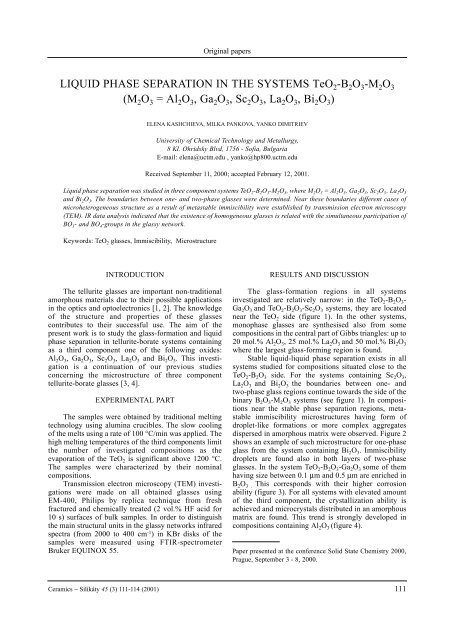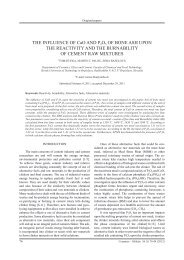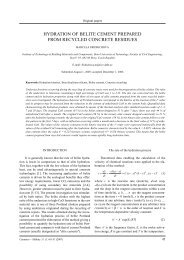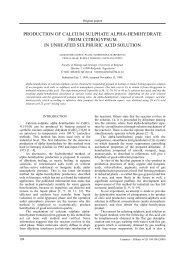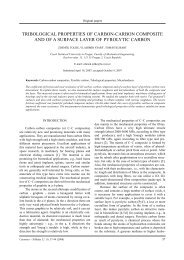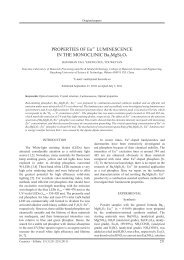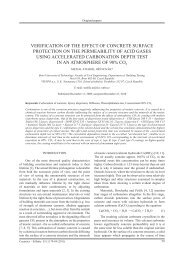M2O3 = Al2O3, Ga2O3, Sc2O3, La2O3, Bi2O3 - Ceramics-Silikaty
M2O3 = Al2O3, Ga2O3, Sc2O3, La2O3, Bi2O3 - Ceramics-Silikaty
M2O3 = Al2O3, Ga2O3, Sc2O3, La2O3, Bi2O3 - Ceramics-Silikaty
Create successful ePaper yourself
Turn your PDF publications into a flip-book with our unique Google optimized e-Paper software.
INTRODUCTION<br />
The tellurite glasses are important non-traditional<br />
amorphous materials due to their possible applications<br />
in the optics and optoelectronics [1, 2]. The knowledge<br />
of the structure and properties of these glasses<br />
contributes to their successful use. The aim of the<br />
present work is to study the glass-formation and liquid<br />
phase separation in tellurite-borate systems containing<br />
as a third component one of the following oxides:<br />
Al 2O 3, Ga 2O 3, Sc 2O 3, La 2O 3 and Bi 2O 3. This investigation<br />
is a continuation of our previous studies<br />
concerning the microstructure of three component<br />
tellurite-borate glasses [3, 4].<br />
EXPERIMENTAL PART<br />
The samples were obtained by traditional melting<br />
technology using alumina crucibles. The slow cooling<br />
of the melts using a rate of 100 °C/min was applied. The<br />
high melting temperatures of the third components limit<br />
the number of investigated compositions as the<br />
evaporation of the TeO 2 is significant above 1200 °C.<br />
The samples were characterized by their nominal<br />
compositions.<br />
Transmission electron microscopy (TEM) investigations<br />
were made on all obtained glasses using<br />
EM-400, Philips by replica technique from fresh<br />
fractured and chemically treated (2 vol.% HF acid for<br />
10 s) surfaces of bulk samples. In order to distinguish<br />
the main structural units in the glassy networks infrared<br />
spectra (from 2000 to 400 cm -1 ) in KBr disks of the<br />
samples were measured using FTIR-spectrometer<br />
Bruker EQUINOX 55.<br />
Original papers<br />
LIQUID PHASE SEPARATION IN THE SYSTEMS TeO 2-B 2O 3-M 2O 3<br />
(M 2O 3 = Al 2O 3, Ga 2O 3, Sc 2O 3, La 2O 3, Bi 2O 3)<br />
ELENA KASHCHIEVA, MILKA PANKOVA, YANKO DIMITRIEV<br />
University of Chemical Technology and Metallurgy,<br />
8 Kl. Ohridsky Blvd, 1756 - Sofia, Bulgaria<br />
E-mail: elena@uctm.edu , yanko@hp800.uctm.edu<br />
Received September 11, 2000; accepted February 12, 2001.<br />
Liquid phase separation was studied in three component systems TeO 2-B 2O 3-M 2O 3, where M 2O 3 = Al 2O 3, Ga 2O 3, Sc 2O 3, La 2O 3<br />
and Bi 2O 3. The boundaries between one- and two-phase glasses were determined. Near these boundaries different cases of<br />
microheterogeneous structure as a result of metastable immiscibility were established by transmission electron microscopy<br />
(TEM). IR data analysis indicated that the existence of homogeneous glasses is related with the simultaneous participation of<br />
BO 3- and BO 4-groups in the glassy network.<br />
Keywords: TeO 2 glasses, Immiscibility, Microstructure<br />
RESULTS AND DISCUSSION<br />
The glass-formation regions in all systems<br />
investigated are relatively narrow: in the TeO 2-B 2O 3-<br />
Ga 2O 3 and TeO 2-B 2O 3-Sc 2O 3 systems, they are located<br />
near the TeO 2 side (figure 1). In the other systems,<br />
monophase glasses are synthesised also from some<br />
compositions in the central part of Gibbs triangles: up to<br />
20 mol.% Al 2O 3, 25 mol.% La 2O 3 and 50 mol.% Bi 2O 3<br />
where the largest glass-forming region is found.<br />
Stable liquid-liquid phase separation exists in all<br />
systems studied for compositions situated close to the<br />
TeO 2-B 2O 3 side. For the systems containing Sc 2O 3,<br />
La 2O 3 and Bi 2O 3 the boundaries between one- and<br />
two-phase glass regions continue towards the side of the<br />
binary B 2O 3-M 2O 3 systems (see figure 1). In compositions<br />
near the stable phase separation regions, metastable<br />
immiscibility microstructures having form of<br />
droplet-like formations or more complex aggregates<br />
dispersed in amorphous matrix were observed. Figure 2<br />
shows an example of such microstructure for one-phase<br />
glass from the system containing Bi 2O 3. Immiscibility<br />
droplets are found also in both layers of two-phase<br />
glasses. In the system TeO 2-B 2O 3-Ga 2O 3 some of them<br />
having size between 0.1 µm and 0.5 µm are enriched in<br />
B 2O 3 . This corresponds with their higher corrosion<br />
ability (figure 3). For all systems with elevated amount<br />
of the third component, the crystallization ability is<br />
achieved and microcrystals distributed in an amorphous<br />
matrix are found. This trend is strongly developed in<br />
compositions containing Al 2O 3 (figure 4).<br />
Paper presented at the conference Solid State Chemistry 2000,<br />
Prague, September 3 - 8, 2000.<br />
<strong>Ceramics</strong> − Silikáty 45 (3) 111-114 (2001) 111
Figure 1. Boundaries between one- and two-phase glass regions<br />
in the systems TeO 2-B 2O 3-M 2O 3: M 2O 3= (1) Al 2O 3; (2) Ga 2O 3;<br />
(3) Sc 2O 3; (4) La 2O 3; (5) Bi 2O 3.<br />
The results of TEM observations show the<br />
influence of the third component on the immiscibility<br />
tendency in different tellurite-borate glasses. In our<br />
previous works [5 - 8], the pronounced trend for cluster<br />
formation in slowly cooled pure vitreous B 2O 3 (v-B 2O 3)<br />
has been discussed. The presence of nano-scale<br />
heterogeneities in v-B 2O 3 ranging in sizes between 1.5 -<br />
2 nm was experimentally established by TEM data<br />
[6, 7]. According to the classification of Zarzycki [9]<br />
and Porai-Koshits [10], they were associated with the<br />
thermal density fluctuations. By means of MM<br />
computer simulation, we made an attempt to model the<br />
cluster formation in borate network at the presence of<br />
BO 3-groups and B 3O 6-boroxol rings [5, 7, 8]. The<br />
addition of TeO 2, containing mainly TeO 3-groups,<br />
stimulates the clustering at micro-scale level [5, 7] and<br />
leads to appearance of metastable phase separation. In<br />
this sense, the role of the third component should be<br />
assigned to its influence on the formation of different<br />
borate or tellurite complexes.<br />
Some typical IR-spectra of chosen compositions in<br />
binary and three component systems are shown in<br />
figures 5 and 6. Their interpretation is based on IR data<br />
analysis of borate glasses [11 - 15]. According to the<br />
obtained IR-spectra the B 2O 3 participates as BO 3- (1380<br />
and 1240 cm -1 ) and BO 4-groups (900 cm -1 ) in the<br />
network of the binary tellurite glass, in spite the small<br />
B 2O 3 amount in the composition (figure 5 - 1). Similar<br />
spectra are obtained when La 2O 3 is added to TeO 2-B 2O 3<br />
glass, but the intensity of the band at 1325 cm -1<br />
increases at the expense of the band at 1215 cm -1 ,<br />
leading to an increase in the tendency for formation of<br />
superstructural units containing BO 3- and BO 4-groups<br />
(figure 5 - 2). This trend is developed (1380, 1050 and<br />
940 cm -1 ) for composition with higher B 2O 3 content<br />
E. Kashchieva, M. Pankova, Y. Dimitriev<br />
Figure 2. Immiscibility droplets and micro-aggregates in onephase<br />
glass with composition 70TeO 2,20B 2O 3,10Bi 2O 3<br />
(mol.%).<br />
Figure 3. B 2O 3-enriched immiscibility droplets in the low layer<br />
of two-phase glass with composition 20TeO 2,70B 2O 3,10 Ga 2O 3<br />
(mol.%).<br />
Figure 4. Microcrystals dispersed in amorphous matrix of glass<br />
with composition 50TeO 2,30B 2O 3,20Al 2O 3 (mol.%).<br />
112 <strong>Ceramics</strong> − Silikáty 45 (3) 111-114 (2001)
Liquid phase separation in the systems TeO 2-B 2O 3-M 2O 3 (M 2O 3 = Al 2O 3, Ga 2O 3, Sc 2O 3, La 2O 3, Bi 2O 3)<br />
Figure 5. IR-spectra of glasses with compositions (mol.%):<br />
(1) - 74TeO 2, 26B 2O 3; (2) - 60TeO 2, 20B 2O 3, 20La 2O 3; (3) -<br />
20TeO 2, 60B 2O 3, 20La 2O 3; (4) - 85TeO 2, 15Al 2O 3; (5) -80TeO 2,<br />
10B 2O 3, 10Al 2O 3; (6) - 60TeO 2, 20B 2O 3, 20Al 2O 3 .<br />
(60 mol.%) and lower TeO 2 content (figure 5 - 3). The<br />
same situation is observed in the spectra of the three<br />
component glasses containing Bi 2O 3 (figure 6 - 1, 2). In<br />
these one-phase glasses, the trend of the formation of<br />
BO 4-units in the network (bands near 900 - 1000 cm -1 )<br />
increases. The appearance of BiO 6-groups is proved by<br />
the band near 480 cm -1 . The spectra of two threecomponent<br />
bismuthate glasses without TeO 2 (figure 6 -<br />
3, 4) are shown for comparison.<br />
The replacement of the La 2O 3 by Al 2O 3 leads to<br />
differences in the IR-spectra (figure 5 - 5, 6). The bands<br />
at 1380 and 1215 cm -1 appear with increased intensity,<br />
while the bands at about 1000 and 900 cm -1 , assigned to<br />
the BO 4-groups, disappear. Probably isolated<br />
BO 3-triangles or more complex units with their<br />
participation are formed.<br />
The vibrations at about 640 cm -1 are characteristic<br />
for tellurite glasses containing TeO 4-groups. Their<br />
displacement towards lower frequencies is connected<br />
with some additional deformation of TeO 4-groups due<br />
to the appearance of more complicated tellurite units<br />
[16, 17]. The opposite displacement of this band<br />
towards higher frequencies (660 - 680 cm -1 ) is<br />
connected with the increasing number of the<br />
TeO 3-groups [18]. Depending on the composition, both<br />
tendencies are observed in the obtained IR-spectra.<br />
The role of the borate units in the network for<br />
determination of the liquid phase separation boundaries<br />
Figure 6. IR-spectra of glasses with compositions (mol.%):<br />
(1) - 60TeO 2, 30B 2O 3, 10Bi 2O 3; (2) - 30TeO 2, 40B 2O 3, 30Bi 2O 3;<br />
(3) - 50B 2O 3, 25Bi 2O 3, 25PbO; (4) - 25B 2O 3, 50Bi 2O 3, 25PbO.<br />
has been discussed recently by Tomozawa [19],<br />
especially in connection with their changes with the<br />
temperature. In our case, we made an attempt to use the<br />
IR-spectral data to explain the correlation between the<br />
glassy network building, the formation of nano-scale<br />
clusters and their further structural evolution towards<br />
different immiscibility structures. As it was discussed,<br />
the tendency of cluster formation is typical for the<br />
borate network containing boroxol rings [5,7,8].<br />
According to the IR-spectra these structural units are<br />
not presented in the investigated three component onephase<br />
glasses which compositions are beyond the<br />
immiscibility regions. Based on these results it is<br />
possible to develop a hypothesis for the reasons<br />
stimulating the tendency for liquid phase separation in<br />
B 2O 3-containing glasses. The formation in the glassy<br />
network of superstructural units containing simultaneously<br />
BO 3- and BO 4-groups is probably the reason for<br />
the depressing tendency to immiscibility, because in this<br />
case only strong bridging bonds are formed in the<br />
network.<br />
CONCLUSION<br />
The boundaries between one- and two-phase<br />
glasses were determined in three component systems<br />
TeO 2-B 2O 3-M 2O 3, where M 2O 3 = Al 2O 3, Ga 2O 3, Sc 2O 3,<br />
La 2O 3 or Bi 2O 3. Near these boundaries metastable<br />
<strong>Ceramics</strong> − Silikáty 45 (3) 111-114 (2001) 113
droplet-like immiscibility microformations were<br />
established. The decrease amount of the boroxol units<br />
and the increasing of the superstructural units,<br />
containing simultaneously BO 3- and BO 4-groups,<br />
improved the formation of the glassy network and thus<br />
stimulated the existence of homogeneous glasses.<br />
Acknowledgement<br />
This work is supported financially by the Bulgarian<br />
National Foundation for Science, under Contract No<br />
HUU-365/2001.<br />
References<br />
1. Nasu H., Natsushita O., Kamiya K., Kobayashi H.,<br />
Kubodera K.: J.Non-Cryst.Solids 124, 275 (1990).<br />
2. Kin H.H., Yoko T, Sakka S.: J.Am.Ceram.Soc. 76, 2486<br />
(1993).<br />
3. Kashchieva E.: Higher Institute of Chemical Technology,<br />
PhD Thesis, Sofia 1984 (in Bulgarian).<br />
4. Dimitriev Y., Kashchieva E., Ivanova Y., Hristova D.:<br />
Building Materials and Silicate Industry 9, 24 (1983) (in<br />
Bulgarian).<br />
5. Kashchieva E., Hinkov P., Dimitriev Y., Miloshev S.:<br />
Proc. 11-th Conf. on Glass and <strong>Ceramics</strong>, Varna, 25-27<br />
Oct. 1993, p.85-92, Eds. Samuneva B., Gutzow I.,<br />
Dimitriev Y., Bachvarov S., “Marin Drinov” Acad. Publ.<br />
House, Sofia 1994.<br />
6. Kashchieva E., Zarzycki J.: J.Non-Cryst. Solids 24, 437<br />
(1977).<br />
7. Kashchieva E., Hinkov P., Dimitriev Y., Miloshev S.:<br />
J.Mater.Sci.Lett. 13, 1760 (1994).<br />
8. Kashchieva E., Shivachev B.: Glastechn.Ber.Glass<br />
Sci.Technol. 71C, 389 (1998).<br />
9. Zarzycki J., in: Proc. 10-th Intern. Congress on Glass,<br />
p.12-28, Kyoto, 8-10 July 1974.<br />
10. Porai-Koshits E.A.: J.Non-Cryst.Solids 142, 81 (1992).<br />
11. Effimov A.M., Mihailov B.A., Arakatova T.G.:<br />
Phys.Chem. Glasses 5, 692 (1979) (in Russian).<br />
E. Kashchieva, M. Pankova, Y. Dimitriev<br />
12. Effimov A.M., Rogova N.P.: Phys.Chem.Glasses 2, 21<br />
(1976) (in Russian).<br />
13. Ram S., Ram K.: J.Mater. Sci. 23, 4541 (1988).<br />
14. Yiannopoulos Y.D., Kamitsos E.I., Chryssikos G.D.,<br />
Kapoutsis J.A.: Proc. 2nd Intern. Conf. on Borate Glasses,<br />
Crystals and Melts, p. 514-521, Abington, UK, July 22-<br />
25, 1996.<br />
15. Chakraborty I.N., Shelby J.E., Condrate R.A.:<br />
J.Am.Ceram.Soc. 67, 782 (1984).<br />
16. Pankova M.D., Dimitriev Y., Arnaudov M., Dimitrov V.:<br />
Phys.Chem.Glasses 30, 260 (1989).<br />
17. Dimitriev Y., Ivanova Y., Dimitrov V., Ioleva A.: Proc.<br />
Int. Conf. on Science and Technology of New Glasses,<br />
p.217-222, Tokyo, 16-17 October 1991.<br />
18. Dimitriev Y., Dimitrov V., Arnaudov M.: J.Mater.Sci. 18,<br />
1353 (1983).<br />
19. Tomozawa M.: J.Am.Ceram.Soc. 82, 206 (1999).<br />
FÁZOVÁ SEPARACE V SYSTÉMECH TeO 2-B 2O 3-M 2O 3<br />
(M 2O 3 = Al 2O 3, Ga 2O 3, Sc 2O 3, La 2O 3, Bi 2O 3)<br />
ELENA KASHCHIEVA, MILKA PANKOVA, YANKO DIMITRIEV<br />
University of Chemical Technology and Metallurgy,<br />
8 Kl. Ohridsky Blvd, 1756 - Sofia, Bulgaria<br />
E-mail: elena@uctm.edu, yanko@hp800.uctm.edu<br />
V trojsložkových systémech byla studována fázová<br />
separace TeO 2-B 2O 3-M 2O 3 (M 2O 3 = Al 2O 3, Ga 2O 3, Sc 2O 3,<br />
La 2O 3, Bi 2O 3). Byla určena rozhraní mezi jedno a<br />
dvojsložkovými skly. V blízkosti těchto rozhraní byla<br />
transmisní elektronovou mikroskopií nalezena mikroheterogenní<br />
struktura jako výsledek metastabilního odmísení.<br />
Analýza infračervených spekter ukázala, že existence<br />
homogenních skel je ovlivněna simultánní účastí BO 3- a BO 4skupin<br />
ve skelné struktuře.<br />
114 <strong>Ceramics</strong> − Silikáty 45 (3) 111-114 (2001)


